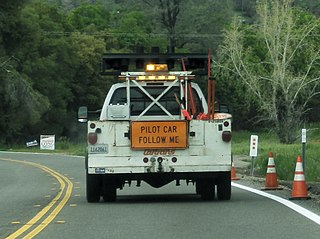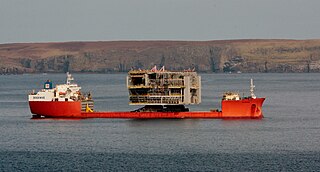Related Research Articles

A semi-trailer truck, is the combination of a tractor unit and one or more semi-trailers to carry freight. A semi-trailer attaches to the tractor with a type of hitch called a fifth wheel.

A skid loader, skid-steer loader, SSL, or skidsteer is any of a class of compact heavy equipment with lift arms that can attach to a wide variety of buckets and other labor-saving tools or attachments.

A forklift is a powered industrial truck used to lift and move materials over short distances. The forklift was developed in the early 20th century by various companies, including Clark, which made transmissions, and Yale & Towne Manufacturing, which made hoists. Since World War II, the use and development of the forklift truck have greatly expanded worldwide. Forklifts have become an indispensable piece of equipment in manufacturing and warehousing. In 2013, the top 20 manufacturers worldwide posted sales of $30.4 billion, with 944,405 machines sold.

A garbage truck is a truck specially designed to collect municipal solid waste and transport it to a solid waste treatment facility, such as a landfill, recycling center or transfer station. In Australia they are commonly called rubbish trucks, or garbage trucks, while in the U.K. dustbin lorry, rubbish lorry or bin lorry is commonly used. Other common names for this type of truck include trash truck in the United States, and refuse truck, dustcart, junk truck, bin wagon or bin van elsewhere. Technical names include waste collection vehicle and refuse collection vehicle (RCV). These trucks are a common sight in most urban areas.

Heavy equipment, heavy machinery, earthmovers, construction vehicles, or construction equipment, refers to heavy-duty vehicles specially designed to execute construction tasks, most frequently involving earthwork operations or other large construction tasks. Heavy equipment usually comprises five equipment systems: the implement, traction, structure, power train, and control/information.

A dump truck, known also as a dumping truck, dump trailer, dumper trailer, dump lorry or dumper lorry or a dumper for short, is used for transporting materials for construction as well as coal. A typical dump truck is equipped with an open-box bed, which is hinged at the rear and equipped with hydraulic rams to lift the front, allowing the material in the bed to be deposited ("dumped") on the ground behind the truck at the site of delivery. In the UK, Australia, South Africa and India the term applies to off-road construction plants only and the road vehicle is known as a tip lorry, tipper lorry, tipper truck, tip truck, tip trailer or tipper trailer or simply a tipper.

A truck driver is a person who earns a living as the driver of a truck, which is commonly defined as a large goods vehicle (LGV) or heavy goods vehicle (HGV).

A loading dock or loading bay is an area of a building where goods vehicles are loaded and unloaded. They are commonly found on commercial and industrial buildings, and warehouses in particular. Loading docks may be exterior, flush with the building envelope, or fully enclosed. They are part of a facility's service or utility infrastructure, typically providing direct access to staging areas, storage rooms, and freight elevators.

A weigh station is a checkpoint along a highway to inspect vehicular weights and safety compliance criteria. Usually, trucks and commercial vehicles are subject to the inspection.

A semi-trailer is a trailer without a front axle. The combination of a semi-trailer and a tractor truck is called a semi-trailer truck.

In road transport, an oversize load is a load that exceeds the standard or ordinary legal size and/or weight limits for a truck to convey on a specified portion of road, highway, or other transport infrastructure, such as air freight or water freight. In Europe, it may be referred to as special transport or heavy and oversized transportation. There may also be load-per-axle limits. However, a load that exceeds the per-axle limits but not the overall weight limits is considered overweight. Examples of oversize/overweight loads include construction machines, pre-built homes, containers, and construction elements.

In Irish and British civil engineering, a banksman is the person who directs the operation of a crane or larger vehicle from the point near where loads are attached and detached. The term 'dogman' may be used in Australia and New Zealand, while 'spotter' is the more common term in United States.

A straddle carrier or straddle truck is a freight-carrying vehicle that carries its load underneath by "straddling" it, rather than carrying it on top like a conventional truck. The advantage of the straddle carrier is its ability to load and unload without the assistance of cranes or forklifts. The lifting apparatus under the carrier is operated by the driver without any outside assistance and without leaving the driver's seat.

A flatbed truck is a type of truck the bodywork of which is just an entirely flat, level 'bed' with no sides or roof. This allows for quick and easy loading of goods, and consequently they are used to transport heavy loads that are not delicate or vulnerable to rain, and also for abnormal loads that require more space than is available on a closed body. Flatbed trucks can be either articulated or rigid.

An articulated hauler, articulated dump truck (ADT), or sometimes a dump hauler, is a very large heavy-duty type of dump truck used to transport loads over rough terrain, and occasionally on public roads. The vehicle usually has all-wheel drive and consists of two basic units: the front section, generally called the tractor, and the rear section that contains the dump body, called the hauler or trailer section. Steering is made by pivoting the front in relation to the back by hydraulic rams. This way, all wheels follow the same path, making it an excellent off-road vehicle.

An escort vehicle, also called a pilot vehicle in most areas, is an automobile used to alert other road users of an upcoming trucks with large loads, convoys of large vehicles or to guide motorists through construction sites. They are also used to guide aircraft taxiing from the runway to the apron at many airports. In most instances, pilot vehicles are provided by companies that specialize in convoy escort, although escort duties are occasionally performed by police vehicles. Some escort companies have special authority for traffic control through state approval.

Vehicle recovery is the recovery of any vehicle to another place, generally speaking with a commercial vehicle known as a recovery vehicle, tow truck or spectacle lift.
A specialized set of jargon describe the tools, equipment, and employment sectors used in the trucking industry in the United States. Some terms may be used within other English-speaking countries, or within the freight industry in general. For example, shore power is a term borrowed from shipping terminology, in which electrical power is transferred from shore to ship, instead of the ship relying upon idling its engines. Drawing power from land lines is more efficient than engine idling and eliminates localized air pollution. Another borrowed term is "landing gear", which refers to the legs which support the front end of a semi-trailer when it is not connected to a semi-truck. Some nicknames are obvious wordplay, such as "portable parking lot", in reference to a truck that carries automobiles.

In transportation, heavy lift refers to the handling and installation of heavy items which are indivisible, and of weights generally accepted to be over 100 tons and of widths/heights of more than 100 meters. These oversized items are transported from one place to another, then lifted or installed into place. Characteristic for heavy-lift goods is the absence of standardization, which requires individual transport planning.
Associated Training Services, commonly known as ATS is a heavy equipment training institution based in Sun Prairie, Wisconsin. It was founded in 1959 by Robert Klabacka as the National Institute of Concrete Construction. The institute offers training programs in heavy equipment, mobile cranes, construction-related trucks, rigging, signaling, and commercial motor vehicles. ATS is one of the oldest training institution in United States of America has been an accredited sponsor providing accredited crane operator certification through the National Center for Construction Education and Research (NCCER), in Alachua, Florida since 2003, and the National Commission for the Certification of Crane Operators (NCCCO)
References
- ↑ "What is a spotter?". Driving Tests Resources. 5 June 2021.
- ↑ "Safe reversing and spotting practices". WorkSafe New Zealand. 18 March 2021.
- ↑ "Vehicles at work: reversing". UK Government Health and Safety Executive.